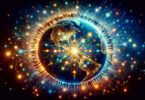By Dakota Flynn
Staff Writer for Wake Up World
The Fabric of the Universe
The concept of interconnectedness is a profound truth that permeates every aspect of existence. From the tiniest particle to the vastness of the cosmos, everything is interwoven in a grand tapestry of life. This idea, often called the “cosmic web,” suggests that all beings and phenomena are intrinsically linked, influencing and reflecting one another. Both ancient spiritual traditions and modern science echo this understanding, revealing a universe bound by unity and interdependence.
Ancient Hindu Philosophy: The Essence of Oneness
[pro_ad_display_adzone id=”110028″]
In the rich tapestry of Hindu philosophy, the idea of interconnectedness is a fundamental principle. The Upanishads, ancient texts of spiritual knowledge, speak of the concept of “Brahman,” the ultimate reality or cosmic spirit. According to these texts, Brahman is the source and essence of everything, manifesting as the universe and all beings within it. This realization is encapsulated in the phrase “Sarvam Khalvidam Brahma,” meaning “All this is indeed Brahman.”
Another significant concept is “Atman,” the individual soul or self. The Upanishads teach that Atman is identical to Brahman, a truth known as “Tat Tvam Asi,” meaning “Thou art That.” This profound teaching emphasizes that the essence of every individual is the same as the universal consciousness. Thus, the perceived separation between individuals and the cosmos is an illusion known as “Maya.”
The Bhagavad Gita, another cornerstone of Hindu philosophy, further elaborates on this interconnectedness. It teaches that all actions and beings are part of the divine play, or “Lila,” of the universe. The Gita encourages individuals to recognize this unity and act with compassion, understanding that harming another is, in essence, harming oneself.
Buddhist Philosophy: The Principle of Interdependence
Buddhism, originating from ancient India, offers profound insights into the interconnectedness of all beings through the principle of “Prat?tyasamutp?da,” commonly known as dependent origination or interdependence. This doctrine asserts that all phenomena arise in dependence upon multiple causes and conditions; nothing exists independently or in isolation. According to this teaching, our thoughts, actions, and even existence are intricately connected to the cosmos.
The concept of “Anatta,” or non-self, further emphasizes the lack of inherent, independent existence in any being or thing. In the practice of mindfulness and meditation, Buddhists cultivate awareness of this interconnectedness, recognizing that suffering and happiness are shared experiences. The Bodhisattva ideal, where one seeks enlightenment for oneself and all beings, encapsulates the commitment to compassion and the collective well-being.
Indigenous Wisdom: The Circle of Life
Indigenous cultures around the world have long recognized the interconnectedness of all life. For instance, Native American spirituality often speaks of the “Circle of Life,” a concept that highlights existence’s cyclical and interconnected nature. In this worldview, all living beings, including humans, animals, plants, and even inanimate elements like water and earth, are considered relatives and part of a larger whole.
The concept of “Mitakuye Oyasin,” a Lakota phrase meaning “All My Relations,” is a prayer and acknowledgment of this unity. It reflects the understanding that every action affects the entire web of life and that living in harmony with the natural world is essential for balance and well-being.
Taoism: The Unity of the Tao
Taoism, an ancient Chinese philosophy and spiritual tradition, teaches that all things are connected through the Tao, the fundamental nature of the universe. The Tao, often translated as “The Way,” is the underlying force that flows through all life, harmonizing and balancing all aspects of existence. Lao Tzu, the author of the Tao Te Ching, describes the Tao as something that is both within and beyond all things, connecting them in an ineffable unity.
The concept of “Wu Wei,” or effortless action, encourages individuals to align themselves with the natural flow of the Tao, recognizing the interconnectedness and interdependence of all things. In doing so, one acts in harmony with the universe, experiencing a sense of peace and unity.
Sufism: The Unity of Being
Sufism, the mystical branch of Islam, also emphasizes the interconnectedness of all beings through the concept of “Wahdat al-Wujud,” or the Unity of Being. Sufis believe that the Divine essence pervades all existence and that every being is a manifestation of this single reality. This belief fosters a deep sense of love and compassion for all creatures, as each reflects the Divine.
Sufi poetry and teachings often describe the journey toward recognizing this unity as a process of awakening and realization. The famous Sufi poet Rumi frequently wrote about the interconnectedness of all life and the importance of love as a binding force that transcends apparent differences.
Ancient Greek Philosophy: The Unity of the Cosmos
In ancient Greek philosophy, the concept of interconnectedness is evident in the teachings of philosophers such as Heraclitus and Pythagoras. Heraclitus posited that the universe is in constant flux and that all things are interconnected through the Logos, an underlying order and reason in the cosmos. He famously stated, “Everything flows,” suggesting that change and interconnectedness are fundamental to the nature of reality.
Pythagoras, known for his contributions to mathematics and philosophy, also believed in the harmony and unity of the cosmos. He taught that the universe operates according to mathematical principles and that everything is interconnected through divine harmony. This belief is encapsulated in the idea of the “Music of the Spheres,” which posits that celestial bodies produce a form of music through their movements, reflecting a deeper cosmic order.
Egyptian Mysticism: The Interconnectedness of the Divine and the Earthly
Ancient Egyptian mysticism and spirituality also emphasized the interconnectedness of all things. The Egyptians believed in the concept of “Ma’at,” a principle embodying truth, balance, order, and harmony. Ma’at was seen as the fundamental law governing both the cosmos and human society, ensuring the interconnectedness and proper functioning of the universe.
The Egyptian understanding of the afterlife and the soul’s journey further illustrates this interconnectedness. They believed the soul, or “Ba,” was connected to the physical body and the cosmos. The soul’s journey after death was a return to the cosmic order, reflecting the interconnected nature of life, death, and the universe.
The Scientific Perspective: A Universe of Connection
Modern science, particularly in the fields of quantum physics and ecology, has begun to uncover the interconnected nature of the universe. Quantum entanglement, a phenomenon where particles become intertwined and instantly affect each other regardless of distance, challenges our conventional understanding of separateness. This discovery suggests that, at a fundamental level, everything is connected.
Ecology, the study of relationships between organisms and their environment, also illustrates interconnectedness. Ecosystems are complex networks where the actions of one species can ripple through the entire system, affecting countless others. This interdependence highlights the delicate balance required for the health and sustainability of the planet.
The Importance of Compassion and Collective Consciousness
[pro_ad_display_adzone id=”110030″]
Understanding the interconnectedness of all beings carries profound ethical and spiritual implications. When we recognize that all life is part of the same cosmic web, the values of compassion, empathy, and respect naturally arise. This awareness fosters a sense of collective consciousness, encouraging us to act in ways that benefit ourselves, others, and the environment.
The ancient concept of “Ahimsa,” or non-violence, in Hindu philosophy, reflects this understanding. It teaches that one should avoid causing harm to any living being, recognizing the unity of all life. Similarly, the practice of “Seva,” or selfless service, is seen as a way to honor this interconnectedness by contributing positively to the world.
Conclusion: Embracing the Reality of Oneness
The message across diverse cultures and philosophies is clear and consistent: We are all fundamentally connected, bound together in a profound and universal oneness. Teachings from ancient traditions like Buddhism, Indigenous wisdom, Taoism, Sufism, Greek philosophy, and Egyptian mysticism all illuminate this essential truth. They reveal that beneath the surface of our differences lies a shared essence, a cosmic web that unites us in an intricate dance of interdependence.
Recognizing this interconnectedness is not just a philosophical insight but a call to action. It challenges us to transcend the illusions of separation and cultivate deep compassion and respect for all life forms. By embracing the reality of oneness, we align ourselves with the natural flow of the universe, fostering a world where love, harmony, and collective well-being are paramount. In this unified vision, every thought, word, and action reverberates through the cosmic web, shaping our shared world. Embracing our oneness is the first step towards creating a more compassionate, harmonious, and enlightened existence for all.
About the Author
Dakota Flynn is an astrologer and spiritual writer known for melding astrology, tarot, and numerology mystical arts with practical guidance. Her insightful writings offer deep reflections on personal growth and cosmic connections, helping individuals navigate life’s journey with clarity and purpose. Dakota’s work serves as a beacon for those exploring the spiritual path, providing tools for empowerment and self-discovery.
[pro_ad_display_adzone id=”110027″]







